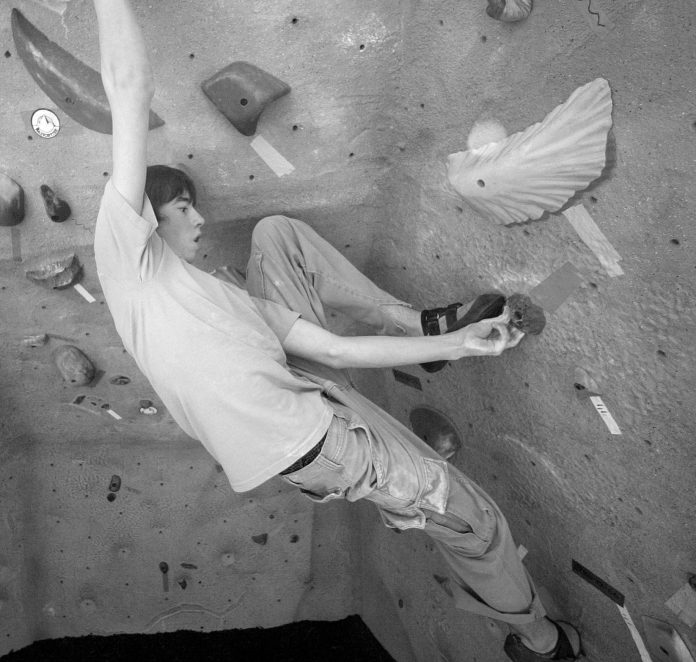Welcome to the Setter’s Archive, where we explore the foundations of modern routesetting through classic wisdom. Here you’ll find essays from famous works in the routesetting field, or simply routesetting articles published years ago that still ring true today. We’re revisiting these stories in their original form because, while much has changed in the routesetting world in the last two decades, many core concepts remain the same. We hope these excerpts from setting experts around the industry help you keep reflecting, learning, and growing professionally.
For more routesetting content, be sure to check out The Impact Driver podcast, Ask a Setter series, Truth Behind the Trade chapters, Behind the Wrench interviews, and other routesetting-related articles on CBJ.
Introduction by Holly Yu Tung Chen
As the routesetting industry goes through growing pains, routesetters and routesetting organizations alike are grappling with the question of how we mentor and educate the next generation of plastic slingers. Unsurprisingly, Setting Tips, written by Scott Rennak in 2003—as part of his Organizer Handbook for hosts of competitions in his American Bouldering Series, and shared with Louie Anderson while the pair collaborated on Anderson’s foundational The Fundamentals of Couresetting book—still serves as a good starting point for routesetters two decades later, because the core of routesetting is all about the athletics of movement.
Rennak was not only a proficient competition setter and organizer; he also had a short career as a commercial setter. He set at Climb Time of Cincinnati (and lived behind the slab wall like a true dirtbag) before he moved to the heart of the Front Range climbing community in Boulder, Colorado, where Rennak set at The Spot Boulder—one of the oldest bouldering gyms in the country—for opening day and beyond.
While trends have come and gone, much of the advice Rennak gives here is still relevant today: not getting trapped into making all cruxes hand-cruxes; how to set moderate problems with bad holds; and why good variety helps even out the playing field. Whether you’re a veteran setter looking to reminisce about the good ol’ days, a novice looking to begin your routesetting education, or a setting educator looking to build a curriculum, Rennak’s 20-year-old “Routesetting 101” exposition is a great place to start.
SETTING TIPS
by Scott Rennak
First and foremost, it must be said that setting is an art. It requires time and dedication—practice makes perfect. Although setting is largely inspiration and visualization, the information covered here should help.
Know yourself as a climber. Know your strengths and weaknesses. Know your ability level for different styles of movement; understanding your own abilities is possibly the most important factor to being an effective setter.
Determine your personal setting style, and deliberately avoid it occasionally. [Like most setters], you probably tend toward a certain style of problem. It might be statics, dynamics, power-fests, technical nightmares, slopers, pockets, crimps—whatever. We all have strengths and weaknesses; just don’t make everyone conform entirely to yours.
In gyms, keep an open mind and listen to your audience. Remember, you’re setting for them. Their input is important and should be heard. Take the time to listen and you might even learn something helpful.
If you’re a comp setter, hang out for the comp. You know the sequences perfectly, but competitors might have trouble. And if they don’t figure out the moves, whose problems are going to get dissed? A little beta, fairly inserted, can help competitors send. And that’s what they’ve come to do.
Climbing outside is the most valuable source of ideas for setting. Mother Nature has formed rock in infinite variety, and much is to be learned from her creations. If your future includes a lot of setting, do yourself and your customers a favor: travel as much as possible. While Mother Nature has infinite resources, you have only what you’ve seen, touched, and climbed on. Climbing on different rock—granite, sandstone, limestone—gives you different experiences to draw from.
GOOD, ENJOYABLE PROBLEMS
It’s a big bite to chew. Who really wants to define a good problem? Every problem is a good problem! If you don’t think so, you aren’t looking at it right. However, I’m going to take the user-friendly stance of a commercial climbing facility in describing a good problem.
A good problem thinks of its audience. Everything about a good problem is mindful of the needs and abilities of the climbers that will be on it. This includes hold selection, body movements, height dependency and, of course, difficulty.
A good problem builds better climbers. For many climbers, the entire purpose of indoor climbing is to get better. Setters are in the unique position of creating the tools to achieve this [objective]. Good problems improve strength, technique, route finding and precision.
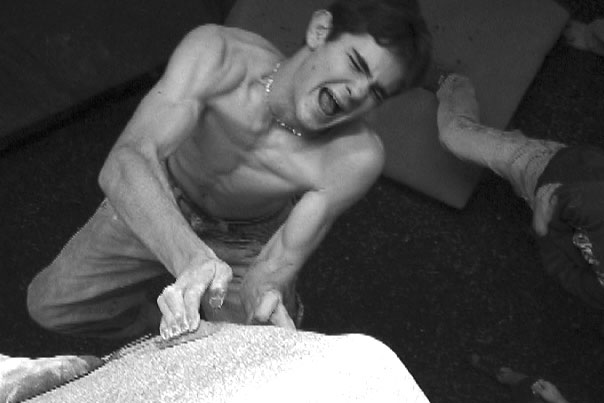
One climber’s favorite problem is another’s worst nightmare. Admittedly, it’s impossible to set problems that everyone likes. However, there are certain aspects of a problem that are, more or less, universally admired.
An enjoyable problem has interesting moves. Creative movement is probably the hardest thing to learn, yet the most important. It’s a product of indoor and outdoor experiences and personal insights into climbing movement. Varied and thought-provoking body movements help make an enjoyable problem.
An enjoyable problem is comfortable to climb. If it hurts, most people won’t like it. This means holds that tweak your tendons, moves that mangle your body, or falls that aren’t fun to take. While those [factors] are all important aspects of outdoor climbing (and should be represented indoors in moderation), they seldom are enjoyable to the general indoor crowd.
PLANNING AND EFFICIENCY
Several weeks before the comp, walk through the entire setting and forerunning process. Good planning can help prevent serious headaches the night before.
Ask yourself: Where should the problems be concentrated? At what maximum density? How many problems, in total? [What about] their grade disbursement? What unique features should be used? How much time will be needed for preparations? How many setters, forerunners, wall-strippers?
The gym will need to be split into rough sections before setting. Problems should be set within the section boundaries. By keeping problems within sections, you’ll maximize the number of people who can climb simultaneously.
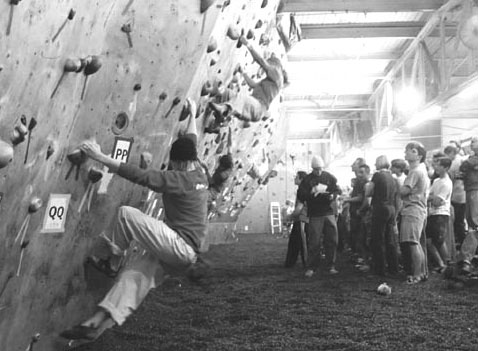
Make as many sections as possible, while leaving adequate room for creative problems. Try to conserve unique features like arêtes and dihedrals, and make good use of them. Mark the boundaries once you’re ready to start setting. Most sections shouldn’t have more than five overlapping problems. Be especially cautious about how the problems are set, avoiding situations where climbers in adjacent sections could fall into each other.
Pre-set problems. Remove the holds after setting and create a map. Or leave the holds in place, but turn them. You can have numerous quality problems ready weeks before the comp, reducing the stress the night before.
Strip bouldering-specific areas first, usually a couple days before the event. Get volunteers or other employees to strip the walls. The setters belong setting; that’s where they’re most useful. Do them a favor and arrange for others to strip the walls.
Spread the difficulty all over the gym, with hard and easy everywhere. Help the climbers to circulate, and allow everyone to climb all the walls. Beginners want to get up the 45-degree walls too.
Having plenty of easy problems is critical. Remember that these events are meant to be fun and inspiring for all levels of climbers. Tailor the grade distribution below to your own clientele.
| DIVISION | OVERALL % | MINIMUM # |
| Recreational | 20% | 7 |
| Intermediate | 20% | 7 |
| Advanced | 40% | 14 |
| Open | 20% | 7 |
There are two principal schools of thought concerning setting efficiency: painstakingly work out the subtlety of every move to perfection, or toss something up that’s fun but might not work exactly how you’d like. Neither is wrong—different circumstances call for both [methods]. For high-end competitions, and high-end problems, being well thought-out and working perfectly is essential. However, for most comps and general gym setting, the time required to achieve this [intricacy] is unavailable.
Problems should be properly marked, labeled and graded no later than one hour before competitors arrive.

HOLD SELECTION
There is no formula for choosing holds. Enough variation in climbing movements prevents any standardized sizing. However, several factors dictate what usability is needed:
- Difficulty of the problem
- Surface angle of the wall
- Orientation on the wall
Handhold usability combines its size and positivity. A half-pad incut and a three-pad sloper might be similarly useable.
Set some easy problems with bad holds; help beginners learn to use them. Take weight off bad handholds with large feet; relieve bad footholds with generous hands. Knee-bars, heel-hooks or the plain old big-honking-jug-foot can make miserable handholds feel great. Opposition moves make tiny edges and smears more tolerable.
Set some hard problems with good holds. Hard problems do not necessitate tweakers; give advanced climbers a break. Use bad (or non-existent) footholds to make large handholds feel worse. Turn big holds into underclings, dyno to them and force climbers to match all over them.
Choose holds that force what you want, no more. Extra features on a hold means extra options. Multi-directional holds and large matching holds give competitors ways around your sequence.
Use screw-ons to make the most of your wall. Screw-on jibs are great for tiny, realistic feet. Larger screw-ons are good for making pinches and slots. Screw-ons aren’t limited by t-nut placements, so they’re inherently better for creating movements exactly the way you want.
Be careful when using large, high-profile holds. They shouldn’t obstruct other problems.

VARIETY, STYLE AND CONSISTENCY
Good variety within a gym or comp is essential, so mix it up. Customers and competitors come to be challenged and to send. They bring their own skills, which may be drastically different than your own. A good setter puts up problems for everybody.
A problem’s style is reflected within its crux(es). These, in turn, create the overall effect of the problem. Ask what makes the problem hard: Does it require power, endurance, or good technique?
The word technical gets thrown around a lot when setting. What is it for a problem to be technical? Answer: to require good route reading and creative use of the body. A technical problem requires knowledge and proficiency in movement and the ability to decipher sequences.
Watch the flow of difficulty throughout a problem. Indoor problems are normally internally consistent (cruxes tend to be within a few grades of the rest of the moves). Early cruxes, while possibly realistic, leave us deflated for the finish—it’s best to spread the difficulty out. Problems that continually get harder, or have several successive cruxes, are perfect for weeding out competitors. Avoid good rests in boulder problems for comps—competitors will hang and shake versus trying, falling and letting the next person go.
Good variety includes:
- Power, endurance and power-endurance problems
- Obvious and devious problems
- Static and dynamic problems
- Smooth, comfortable problems and awkward, realistic problems
- Hard slabs and easy overhangs
- Underclings, gastons, and sidepulls
- Slopers, crimpers, pockets and pinches
- Big right-hand moves and big left-hand moves
- One-move-wonders and enduro-fests
- Sit-starts and jump-starts
Each individual problem can include much of the above, or little. Theme problems (e.g. pocket or gaston problems) reward climbers’ strengths, isolate their weaknesses, and are great to have in moderation.
Don’t get trapped into making all cruxes hand-cruxes. Remember, hands and feet working together determine a move’s difficulty. Use evil smears, tiny edges and scummy heel-hooks as cruxes too.
Good variety evens the playing field. It demands a climber to be well-rounded to excel. At competitions, this [even playing field] is the goal. Ensure a fair fight; set good variety.
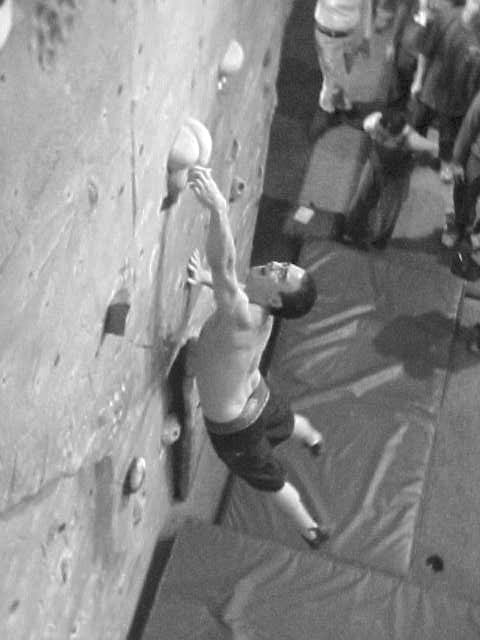
HEIGHT DEPENDENCY
“I tried, but I just couldn’t reach the next hold.” We’ve all heard and probably said this [sentence]. Outdoors, it means turn it on or find a new problem. Indoors, there are many implications. Luckily, we have the opportunity to prevent height–dependent indoor problems, should we want to.
Most problems should not be height-dependent, to make them fun for everybody. Especially with the growing number of youth [climbers] coming to gyms, it’s financially unwise to beat them up with reaches. However, if everything goes for kids, what’s left to challenge the rest of us?
Some problems should be height-dependent. I might get [ridiculed] for saying that statement. Don’t get me wrong, we all want [young climbers] to send. We also want them to appreciate problems they can’t do. If you can’t get away with having a few height–dependant problems, offer alternative holds for Juniors and give them boosts to high starts.
The ignored cousin of the reach, the scrunch is equally disabling. We normally don’t worry much about tall climbers; things always seem easier for them. Abundant in the form of low traverses and butt-dragging sit-starts, scrunchy problems should not be overdone.
Several distances to keep in mind, any one of which can cause height dependency:
- Hand-to-hand
- Hand-to-foot
- Foot-to-foot

Prevent height-dependent problems with additional feet. Place extra feet high, low or to the side, where only tall or short climbers will use them. Make long moves easier with high feet, low starts easier with wide feet. Occasionally, extra footholds become hands for the small-fingered; we all know that local 45-pounder who monos bolt-holes.
Height-dependent problems shouldn’t decide winners at comps. Therefore, for every height-dependent problem, set several others at the same grade that aren’t. With enough carefully set alternatives, even the most self-righteous competitor can’t argue.
FORCING MOVES
“Hey, that’s not how it goes!” Setters hate it; there’s seemingly always another way to do a problem, a testament to the variety in abilities among climbers. However, skipping sequences is often preventable.
Before grabbing the wrenches and attacking the holds, question the necessity of a change. Often good problems (indoors and outdoors) are done with alternate sequences. Given that the different methods are similar in difficulty, does their difference actually matter? One person’s easiest way up is sometimes another’s hardest. If the sequences require contrasting techniques, more variations make the problem more accessible.
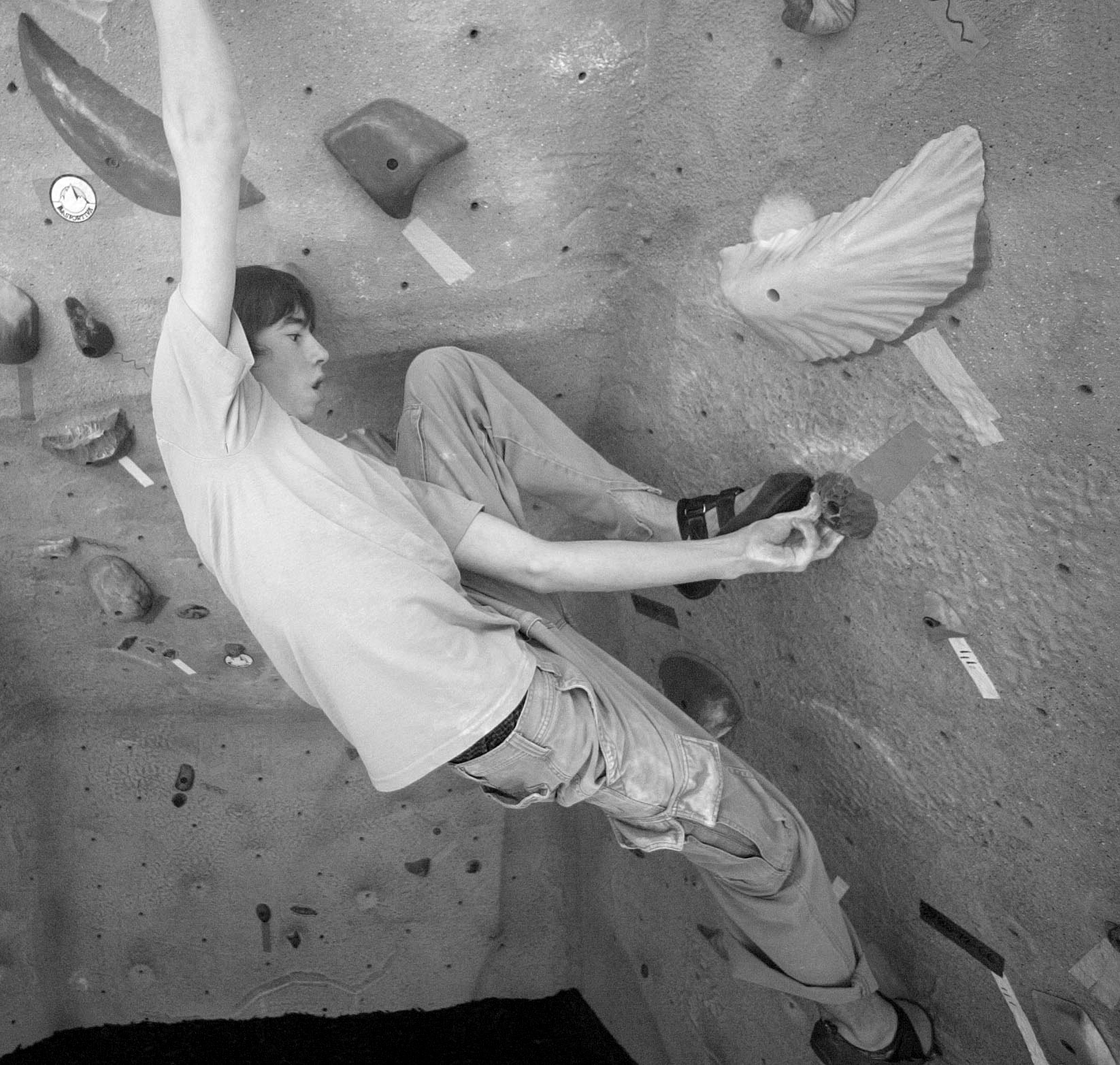
Every hold on a problem provides an option, sometimes several. Too many holds can mean too many options. It’s generally not an issue with hands; most setters don’t put extra handholds on a problem. Many do, however, include superfluous footholds. Extra feet, while often increasing your problem’s overall sendability, reduce the chance competitors will use your sequence. Only holds needed for a send should be on the wall (by people of differing heights, of course). Avoid unnecessary multi-directional holds and holds large enough to match.
Make your sequence the easiest way up (the easiest to those for whom the problem is intended). If another sequence or way to grip a hold is possible, try it: back-step vs. toeing-in; gaston instead of crossing-through. Most problems can go differently, but at vastly different grades. If the alternate [way up] is harder, you’re okay; easier, and it’s time to grab the wrenches and tweak.
Climbers like to jump. They will, and right past your moves if you let them. Never underestimate the airtime of a psyched-up climber. Especially watch problems that cross back over (above) themselves. Where dynos are possible, put the feet low or to the side. The dyno becomes more awkward, and less likely.
LABELING PROBLEMS
Mark all holds and features clearly. Nothing causes as much mayhem as poorly labeled problems. All natural features should be labeled “in” or “out”. Special instructions (e.g., sit-down start, any feet, arête is in) should be noted clearly at the start of the problem. Beginning and ending holds should be designated.
Labels need to be seen from all vantage points on a problem. Handholds used later as feet need to be visible from the higher position. Use two labels if necessary.
Avoid situations where the label will be worn off with traffic. Foothold labels especially are prone to being rubbed off. Labels that wear off are great fuel for picky climbers.
Mark problems that overlap with obviously different colors (not hard with so many colors available). Also, using sponsor stickers as problem markers adds spice to the appearance, and gives recognition to your supporters.
For comps, every problem should be labeled with its number and total point value. The labels should be written in large, clear print with a bright–colored marker.

FORERUNNING
Forerunning consists of attempting, critiquing, altering and grading a problem. The focus is improvement; a well-forerun problem achieves the desired movement at the desired grade.
Grades represent a problem’s consensus difficulty, ideally; [in other words], how hard it is for a climber of average height and weight, with average flexibility, finger strength, and technique. For anyone else, it could feel vastly different. Several people, with different styles and strengths, should forerun each problem.
It’s hard to grade problems well below your ability. Continually think about the effort needed to grab onto and move between the holds. Don’t underestimate your finger strength, power or technique. Consider the appropriateness of moves. Sure, that rose-move is rad, but on a V0?
Work out as many moves as you can on projects. Put a jug ladder nearby to avoid working it ground-up. Think carefully about every move and every stance. After working it, compare it to the other hard problems. Try to rank them in order of difficulty, and then guesstimate the grades.
While the V-system is widely used, its interpretation varies. One region’s V8 is another’s V6. No matter—the real deal is to have internal consistency. Two problems given the same grade in a gym should be the same difficulty.
At competitions, achieving consistency is like pulling teeth. With limited time and energy, it’s difficult to accurately grade everything. Fresh forerunners, who come in later in the setting process, can help that consistency happen.
| V-SCALE | YDS | ABS POINTS |
| V0- | 5.0 to 5.8 | 10 |
| V0 | 5.9 | 15 |
| V0+ | 5.10- | 20 |
| V1 | 5.10+ | 30 |
| V2 | 5.11- | 40 |
| V3 | 5.11+ | 60 |
| V4 | 5.12- | 80 |
| V5 | 5.12 | 120 |
| V6 | 5.12+ | 160 |
| V7 | 5.13- | 240 |
| V8 | 5.13 | 320 |
| V9 | 5.13+ | 480 |
| V10 | 5.14- | 640 |
This scale has proven to split the ability levels well. To minimize ties, try to give each problem a different grade. For example, two easy V4s might get 74pts and 76pts. Long or high problems should be a little overrated to compensate for the extra energy and attention they require.
Every move of every problem should be forerun in competitions. Too many comp problems never get sent, or are improperly graded, because of assumptions. It may not be necessary to actually do a move to educate a guess about its feasibility and relative grade. However, guessing how a move will go, without trying it, is unacceptable.


Scott has been promoting indoor climbing since 1997 when he bought Climb Time of Cincinnati and started what would become the American Bouldering Series. Since then he has helped hundreds of small businesses grow including climbing gyms and manufacturers. Scott is the owner and publisher of CBJ, and is available for projects through Reach Climbers. In his free time he still scours nearby hills for fresh boulders, skis all year, and is a dedicated father.




